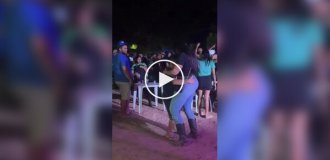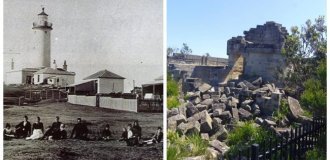How poachers fish in Astrakhan (15 photos + video)
Today I want to tell you about how and with what terrible methods poachers catch valuable fish in Astrakhan. I recommend reading the photo report in the continuation of the post, as well as watching the video below.
It so happened that one of the representatives of this “profession” agreed to talk to me. From the base where our company was vacationing, we drove several hours to another area for this meeting. For obvious reasons, I cannot show my hero. I will only say that Vasily, an elderly man and a native resident of the Astrakhan region, grinned and introduced himself as a “hereditary poacher.” According to him, his grandfather, father and many men in the family were involved in poaching.
Before starting the story, I want to outline my own attitude towards this phenomenon. Obviously, like any normal person, I am against poaching. I have been going to Astrakhan for 8 years and I see with my own eyes that every year there are fewer and fewer fish. Poachers who hunt for black caviar kill and throw overboard half a ton of sturgeon per trip. During the season, only one poaching team destroys almost 50 tons of sturgeon, which is then not found in the store. However, the problem is not only the thirst for profit of those fishermen who break the law. It is deeper - in the low standard of living, lack of alternatives and monstrous corruption. Bribes for poaching amount to tens and hundreds of millions of rubles a year! But first things first...
In order to talk about how poachers break the law, it is worth first talking about these laws:
- Firstly, in order to fish on a commercial scale, you need a special permit, which is issued by the Volga-Caspian Territorial Department of the Federal Fisheries Agency. Every fishing season, peasant fishermen receive such permission and only with a piece of paper in their hands do they go out fishing.
- Secondly, you can only fish at certain times of the year. This period is called Putin. There are two seasons a year - summer and winter. This was done for obvious reasons - the fish need to spawn and “rest” from the fishermen.
- Thirdly, the process of commercial fishing is clearly regulated, down to how much of which type of fish can be caught, how to catch it and where to catch it. Prohibited fishing tools (nets, hooks), violation of the quota - this is poaching.
So, having arrived at the place, Vasily first of all showed those tackles that are prohibited - a trap line and a net. We got on the boat and went to the sunset. Vasily showed those fishing grounds that are located near the village - they are used mainly for themselves, since you won’t catch much near the village. Accordingly, poaching can be divided into two types: domestic (when fish are caught, roughly speaking, for home use) and commercial (when fish are caught for sale).
Along the way, Vasily pointed to the boat: “If you see a small boat with a powerful motor, it’s most likely a poachers’ boat.” Those who are serious about poaching put two or even three engines on their boat. This is necessary in order to evade border guards at sea...

Vasily could not show a serious boat. In the village, of course, no one keeps them near the house. However, there are a lot of photographs of these boats confiscated by border guards online:

Poaching boats in the Caspian Sea are called canoes. They have a shallow draft, with an average length of about 10 meters. The design and shape of the boat are such that they allow it to overcome sea waves. The total power of several outboard motors reaches 700 horsepower. This allows you to reach speeds of more than 100 km/h even when the canoe is loaded with a serious catch of up to half a ton. According to Vasily, the cost of a normal poaching boat ranges from 300 thousand rubles to one million.

Motors (purchased separately) are the most valuable thing in the canoe. In the RIA Novosti report (at 1 minute 34 seconds) there is an episode that clearly illustrates this:
“The only way to prevent a canoe from escaping is by shooting through its engines, so the poachers literally fall on them - the border guards will not shoot at people...”
Where do poachers keep their canoes? Vasily said that for this purpose, each poacher has a hiding place in the rocks, which is almost impossible to find without GPS. Baida is hidden in the tufts, overgrown reeds, which stretch for hundreds of kilometers. Poachers choose a suitable peg, drive four sticks into the bottom, stretch ropes between them - they get a box. This box is tied with live reeds - they do not cut it, but simply tie together the plants growing nearby to make a wall of reeds. A camouflage net is pulled over the top, so even from a helicopter it is impossible to notice the canoe.
Imagine how easy it is for a poaching boat to get lost here:

I will talk in detail about commercial poaching at sea below. Meanwhile, we entered a small erik (channel). There were no identifying marks at this place; Vasily said that he was guided by the trees. He took a grappling anchor, threw it into the water and began to float downstream:

At some point, he hooked the order and lifted it out of the water:

Order is a self-catching hook tackle. It is a rope onto which leashes with hooks are fastened. However, no bait is put on the sharply sharpened hooks - they simply catch the fish on the sides as it passes nearby. The order stands at a height of 1 centimeter from the bottom and any fish that swims along the bottom inevitably clings to the hooks:

Tackle is ordered from Rostov. According to fishing superstition, the number of hooks should be odd - for example, if you get 90, add one more. Hooks are hung at a distance of 10 centimeters from each other:

The use of self-catching saddles was already prohibited by Peter I:

Vasily has two orders near his house for 71 and 91 hooks. They check them every evening. Usually one or two sturgeon are caught on them per day, but that day the entire catch consisted of two crucian carp. The fish were killed in such a way that no superstitions can save them:

Then Vasily went to show the net for carp. The net is marked with a stick and it covers the entire erik - all the fish that passes through the channel ends up in the net:

The cat also gets the net. The cell is large, so small fish pass through, but large ones are caught:

I asked Vasily what would happen if tourists accidentally caught the net with a spinning rod? He waved his hand and said that he didn’t see anything wrong with it. The network can be repaired or another one can be installed.
In one article about poaching, I came across a very important idea. In a nutshell, the essence is this: a long time ago, during the reign of Tsar Peas, they also caught them with nets. But then every network was worth its weight in gold. The nets took weeks to make by hand and were treasured. And now you can easily buy any mesh, lose it, tear it or forget it, and immediately find another one...

So, in addition to domestic poaching, there is commercial poaching - that which causes the greatest harm. It happens at sea.
The poachers walk from the village to the peals for about an hour in a simple boat. They use a navigator and leave in the evening, when it begins to get dark. Arriving at the place, they transfer to a canoe, hide the boat in the reeds and go out to sea. From the last stake with reeds to the first sea order is about 70 km. They walk for about 40 minutes. They return home when it begins to get light. They go to the sea every other day, that is, 15 times a month, if everything is fine with the weather. If there is a storm at sea, they can spend the night in pegs (during the day) and return in a couple of days.
While commercial fishermen work only during the fishing season, poachers fish until there is ice - from March to November. Vasily has 12 orders of hooks at sea from 201 to 401, that is, 20 to 40 meters each. On average, half a ton of fish is lifted per trip: the bottom of the boat is not visible, they walk on the sturgeon. Orders are found using the navigator. If you miss a day (for example, due to bad weather), the fish will dry out. We'll have to put things in order, remove the spoiled catch and put it back in again.
Having taken out the gear, the poachers dump all the fish into the boat and begin looking for caviar. According to Vasily, half a ton of sturgeon contains two or three fish with caviar. They squeeze the caviar into a bag and throw away the sturgeon. Why? A heavy boat consumes more fuel, and you can’t sell that much sturgeon to anyone. If there is caviar, it is enough to justify the trip, since the cost of black caviar is 24 thousand per kilogram. Sturgeon - 400 rubles per kilogram. Sevruga - 350 rubles per kilogram. If we assume that on average six kilograms of caviar are produced per half ton, the revenue will be about 140 thousand rubles.
On average, poachers earn 170 thousand rubles per trip: 150-140 thousand on caviar and 20-30 thousand on meat (about 50 kg - the rest of the fish is thrown away).

As Vasily says, at sea they are only afraid of border guards, so they travel at night. They work with the engines turned off and if they hear the noise of approaching engines, they throw everything overboard and quietly drive away from the order. After the boats pass, they return.
With the regulatory authorities, according to Vasily, the issue is resolved simply - with bribes. According to the established “tariff”, one poaching trip to the sea “costs” 50 thousand rubles, and you have to pay in any case, even if there is no catch. If you don't pay, there will be problems. Their own “colleagues” from the village can donate it. If you calculate an average of 12 trips per month, you get 600 thousand rubles in bribes from one poaching team. According to Vasily, there are 10 such teams working in his area. That works out to 6 million per month or 48 million per year for an 8-month season. Incredible numbers. And this is only from one district in the Astrakhan region.
In the village, according to Vasily, “Rosrybolovstvo sleeps both day and night.” All they do is pinch tourists with spinning rods and fine fishermen. Residents of Astrakhan have repeatedly expressed dissatisfaction with the work of the department. This year, with the beginning of the Putin season, commercial fishermen completely blocked the Volga delta in order to at least somehow pay attention to what the Volga-Caspian Territorial Administration was doing:

This is all very sad. Even Vasily admits that this is wrong - according to him, 20 years ago there were 100 times more fish. It's scary to imagine what will happen in another 20 years...





















